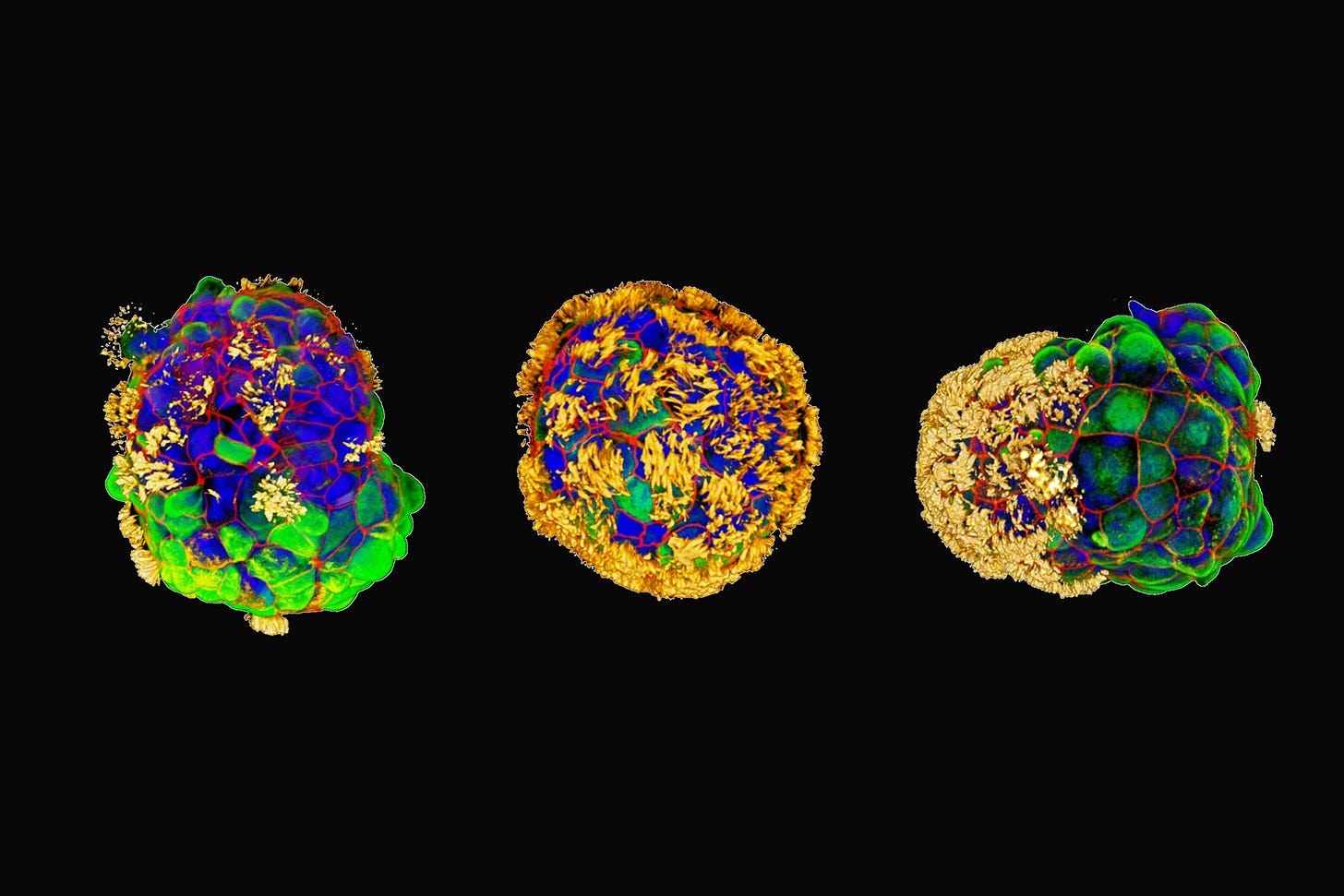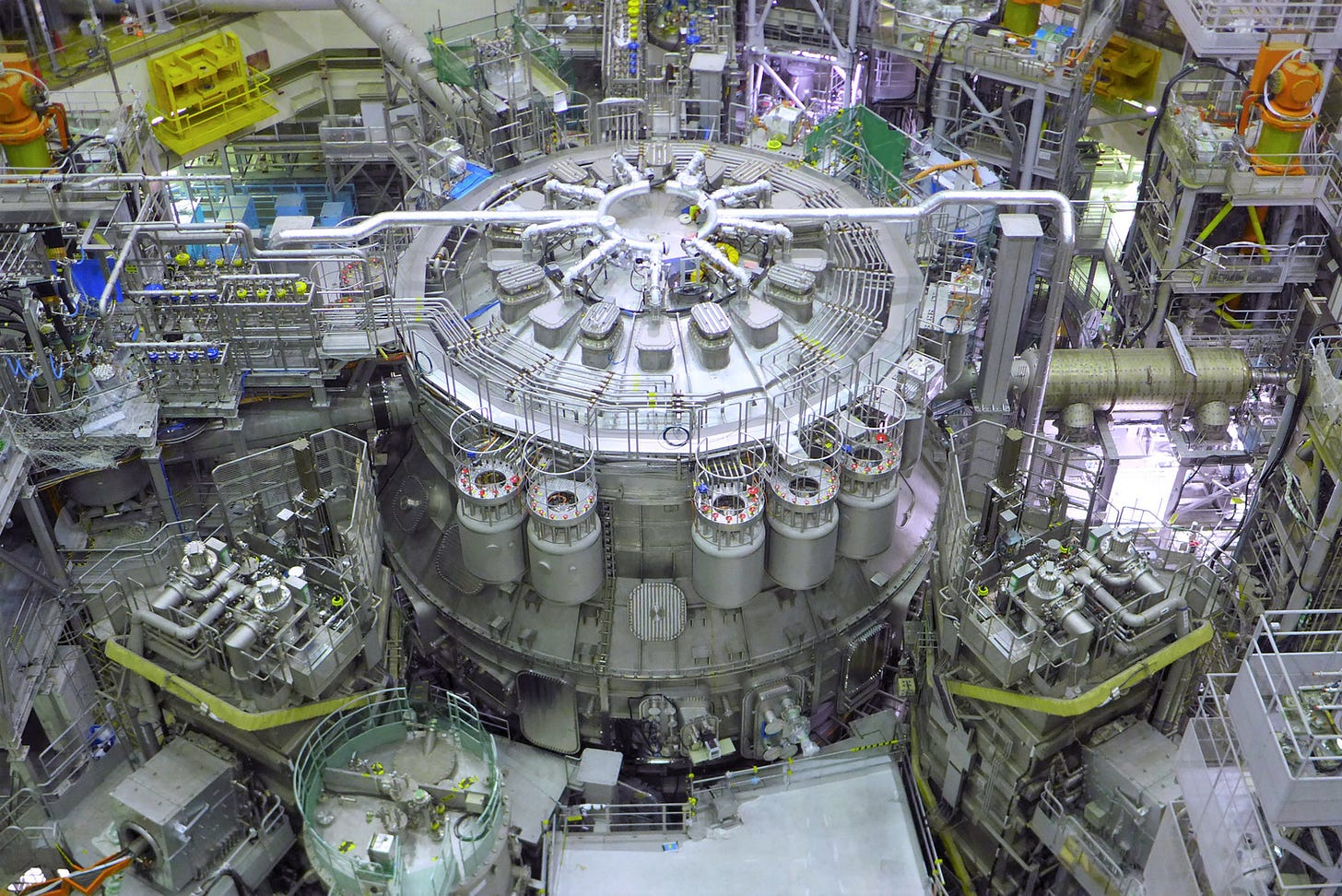Welcome to this update from New World Same Humans, a newsletter on trends, technology, and society by David Mattin.
If you’re reading this and haven’t yet subscribed, join 25,000+ curious souls on a journey to build a better future 🚀🔮
To Begin
It’s a bumper instalment this week; what do we have in store?
Google DeepMind owned this week’s tech headlines with the release of Gemini, a new multi-modal AI intended to outdo GPT-4.
Meanwhile, Harvard researchers have created tiny biological robots that can heal human tissue.
And the world’s largest nuclear fusion reactor is now online in Japan.
Let’s go!
Gemini has liftoff
This week, major news out of Google’s DeepMind AI division.
The DeepMind team announced Gemini, a multi-modal LLM that looks to have pushed back the frontiers when it comes to these kinds of AI models.
Launch videos suggest Gemini can speak in real-time (though as I go to press doubts about that are being raised; more below). It understands text and image inputs, and can combine them in novel ways. Here it is giving ideas for toys to make out of blue and pink wool:
It can write code to a competition standard. In tests it outperformed 85% of the human competitors it was compared against; that means it’s excellent even when compared to some of the best coders on the planet.
Gemini can even perform sophisticated verbal and spatial reasoning, and handle complex mathematics. Imagine if you’d had this to help with your homework:
This is significant; OpenAI’s GPT-4 is notoriously bad at maths and logic puzzles.
And Google are, of course, taking direct aim at OpenAI with this launch. Gemini comes in three variants: Ultra, Pro, and Nano. US users can access the Pro version now via Bard, and the Ultra model will soon be made available to enterprise clients.
⚡ NWSH Take: It will take time to independently verify the claims DeepMind are making; there are some murmurs that their launch videos overstate Gemini’s competence. Still, there’s no denying this model looks impressive. // Scratch the surface, meanwhile, and we can discern some underlying signals about the future development of LLMs. This AI outperforms GPT-3.5 when it comes to linguistic tasks such as copy drafting. But it’s the multi-modal nature of Gemini that’s really significant; in particular, its ability to reason. LLMs are trained to do next word prediction; that means they’re brilliant at sounding right. But they lack any underlying ability to know whether what they’re saying is right, or even makes sense. Gemini seems to address this shortcoming. The promise of an LLM that can act as a true reasoning partner is exciting, should haunt the dreams of all at OpenAI. // OpenAI’s reported work on the still-mysterious Q* algorithm is also believed to be about reasoning. All this suggests we’re hitting the limits of the performance improvements to be gained simply by training LLMs on even larger data sets. Instead, the future belongs to those who can weave multiple models together. // Finally, a word for Alphabet’s CEO Sundar Pichai: kudos. Alphabet AI engineers invented the transformer model; then the company went missing. Gemini puts Alphabet firmly back in the race. And given the recent fiasco at OpenAI, Pichai this week looks like a man playing a canny long game. It’s going to be a fascinating 2024.
🤖 Anthrobots are go
Two stories this week signal powerful new avenues of discovery for the life sciences.
Scientists at Harvard and Tuft’s University have created tiny biological robots, called anthrobots, made out of human cells. In tests, the anthrobots were left in a small dish along with some damaged neural tissue. Scientists watched as the bots clumped together to form a superbot, which then repaired the damaged neurons.
Each anthrobot is made by taking a single cell from the human trachea. Those cells are covered in tiny hairs called cilia. The cell is then grown in a lab, and becomes a multi-cell entity called an organoid. In this case, the scientists created growth conditions that encouraged the cilia on these organoids to grow outwards; they then become something akin to little oars that allow the entity to move autonomously. And lo, an anthrobot has been created.
The researchers say that in future anthrobots made from a patient’s own cells could be used to perform repairs or deliver medicines to target locations.
Meanwhile, researchers at New York University created biological nanobots capable of self-replication. The bots are made from four strands of DNA, and when held in a solution made of this DNA raw material they’re able to assemble new copies of themselves.
⚡ NWSH Take: Organoids have long been a NWSH obsession. This work on anthrobots builds on the research — by the same team — that created xenobots, which I wrote about back in December 2021. And who can forget the brain organoids that taught themselves to play Pong, which I covered in October of last year? // The original xenobot researchers at Harvard and Tufts were startled when their bots first began to work together in groups, self-heal, and self-replicate. But xenobots are made out of frog cells, and so have limited applications when it comes to humans. Anthrobots, on the other hand, are human in origin. Given their ability to heal other tissues, they show immense promise when it comes to new medical and wellness treatments. // As so often at the moment, machine intelligence underpins these advances. To create the original xenobots, AI supercomputers were used to ‘simulate a billion year’s worth of evolution in just a few days’. No wonder Nvidia CEO Jensen Huang says ‘digital biology’ will be a central part of the AI story over the coming years. I’ll keep watching.
💥 Come together right now
The world’s largest nuclear fusion reactor came online in Japan this week.
JT-60SA, in the Ibaraki Prefecture, is an experimental reactor capable of heating plasma to 200 million degrees celsius. Scientists say it offers the best chance yet to test nuclear fusion as a source of near-infinite clean energy.
In fusion, two or more atomic nuclei are smashed together such that they become one; this results in an energy release.
Meanwhile, UK-based Rolls Royce showcased a prototype lunar nuclear fusion reactor, which they say could power a permanent human settlement on the Moon.
⚡ NWSH Take: Fusion is the energy dream that has remained, so far, just out of reach. It doesn’t output CO2. It doesn’t create a lot of dangerous nuclear waste, as fission does. And proponents say it could mean near-infinite renewable energy, on tap. // And now, we’re getting closer. Last year saw the first controlled fusion reaction that generated more energy than was needed to make the reaction happen: this is the longstanding net energy gain goal. And now a startup ecosystem is flourishing; US-based Helion, for example, are working to build the world’s first commercial fusion reactor. And they’ve laid down a clear timeline: the startup recently signed a deal with Microsoft to supply the tech giant with energy starting in 2028. // It remains to be seen whether Helion, or anyone else, can achieve fusion in this decade. But if someone does, it will be a transformative moment; and we’re closer than ever.
🗓️ Also this week
🧮 IBM announced Quantum System Two, its most powerful quantum computer. The system integrates three 133-qubit Heron processors. IBM also announced Condor, a new 1,000-qubit processor.
IBM are leading the way, right now, towards useful and utility-scale quantum supercomputers. If that promise is realised it will unlock insane new capabilities across climate simulation, the creation of new medicines, supply chain management and more. Read an interview with IBM’s director of quantum, Jerry Chow, here.
🖼 Stability AI’s new image generator can create 150 images per second. StreamDiffusion is built on top of Stability AI’s sd-turbo image generation model. And X users are using it to create tens of thousands of cat pictures.
🦾 The humanoid robot currently in trials inside Amazon warehouses will eventually cost just $3 an hour to run. The CEO of Agility Robotics, Damion Shelton, says the Digit robot currently costs around $12 an hour to operate, but this will fall rapidly once mass production starts. The median wage for workers in Amazon’s US fulfilment centres is $18 an hour. Agility will open the world’s first humanoid robot factory in Oregon in 2024.
✋ US officials have warned chip maker Nvidia to stop redesigning its AI chips in an attempt to get around restrictions on exports to China. The US recently imposed restrictions on sale of advanced AI chips to China; meanwhile the 2022 US CHIPs act will pour over $250 billion into US domestic chip design and manufacturing capability.
💡 A research team at Google got ChatGPT to spit out its training data. The team asked ChatGPT to repeat the word ‘poem’ forever; this caused the app to produce huge passages of literature, which started to contain snippets of the text that the underlying AI model was trained on. OpenAI don’t want to reveal the data sets used to train GPT-4 and other models; Ilya Sutskever, their chief scientist, says training data amounts to part of the company’s ‘technology’.
🇨🇳 Meta says China is ‘stepping up’ its attempts to manipulate public opinion in the Global North. The company says it’s taken down five networks of fake Chinese accounts this year: the most originating from a single country. The accounts were posting content that, among other things, attacked critics of the CCP.
🔥 Average global temperatures hit 1.4C above pre-industrial levels this year. The World Meteorological Organization’s State of the Global Climate report says 2023 will be the hottest year on record; it will surpass the hottest to date, 2016, by a considerable margin. Two weeks ago I wrote on how Earth for the first time broke the 2C heating barrier during two successive days in November of this year.
👴 The XPrize Foundation has launched what it says is the largest competition in history — for research that advances human longevity. The Healthspan Prize will award $101 million to the team that develops a therapeutic that can, in one year, restore muscle, cognition, and immune function by a minimum of 10 years in people aged 65 to 80. The prize has been launched in partnership with the Hevolution Foundation, a new Saudi-based organisation dedicated to funding longevity research.
😴 A new startup says technology-induced lucid dreaming could enable people to work while asleep. Prophetic say their headband, the Halo, releases pulses of ultrasound waves into a region of the brain associated with lucid dreams. CEO Eric Wollberg says that the ability to remain in control of their choices while they dream could enable users to write code or work on a novel while they are sleeping.
🌍 Humans of Earth
Key metrics to help you keep track of Project Human.
🙋 Global population: 8,077,686,653
🌊 Earths currently needed: 1.81672
🗓️ 2023 progress bar: 94% complete
📖 On this day: On 8 December 1980 John Lennon is shot and killed outside the Dakota Building in New York City.
La Mode
Thanks for reading this week.
We’ll soon learn more about DeepMind’s new Gemini model, and whether it’s really as capable as the launch videos suggest.
Either way, the ongoing collision between machine intelligence and human creativity is momentous; and a classic case of new world, same humans.
I’ll keep watching, and working to make sense of it all.
Now you’ve reached the end of this week’s instalment, why not forward the email to someone who’d also enjoy it? Or share it across one of your social networks, with a note on why you found it valuable. Remember: the larger and more diverse the NWSH community becomes, the better for all of us.
I’ll be back soon. Until then, be well.
David.
P.S Huge thanks to Nikki Ritmeijer for the illustration at the top of this email. And to Monique van Dusseldorp for additional research and analysis.















